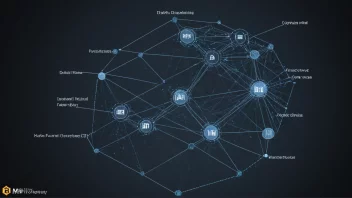Cryptographic hashing algorithms are fundamental to the security and integrity of digital information. They serve as the backbone of numerous technologies, notably in blockchain systems, data integrity verification, and secure password storage. This article delves into the intricacies of cryptographic hashing algorithms, explaining their functionality, various applications, and the specific roles they play in modern technology.
What is a Cryptographic Hashing Algorithm?
A cryptographic hashing algorithm is a mathematical function that converts an input (or 'message') into a fixed-length string of characters, which is typically a sequence of numbers and letters. The output, called the hash value or digest, is unique to each unique input. Even the slightest change in the input will produce a drastically different hash, thus ensuring data integrity.
Characteristics of Cryptographic Hash Functions
- Deterministic: The same input will always produce the same hash output.
- Fast Computation: It should be computationally easy to generate a hash from any given input.
- Pre-image Resistance: It should be infeasible to generate the original input from its hash output.
- Small Changes Impact: A small change to the input should produce an uncorrelated change in the output (the avalanche effect).
- Collision Resistance: It should be improbable that two distinct inputs will produce the same hash output.
Popular Cryptographic Hashing Algorithms
Several cryptographic hashing algorithms are widely used today. Each has its strengths and weaknesses, making them suitable for different applications.
MD5 (Message Digest 5)
Once a popular hashing algorithm, MD5 produces a 128-bit hash value. However, it is no longer considered secure due to vulnerabilities that allow for collision attacks, where two different inputs yield the same hash. Despite this, MD5 is still used for checksums and data integrity verification in non-critical applications.
SHA-1 (Secure Hash Algorithm 1)
SHA-1 generates a 160-bit hash value. Similar to MD5, SHA-1 has been found to be vulnerable to collision attacks, making it unsuitable for security-sensitive applications. Many organizations have migrated to more secure algorithms.
SHA-256 and SHA-3
SHA-256, part of the SHA-2 family, produces a 256-bit hash and is widely used in blockchain technology, including Bitcoin. SHA-3 is the latest member of the Secure Hash Algorithm family, designed to offer better security and performance. Both SHA-256 and SHA-3 are currently considered secure for most applications.
Applications of Cryptographic Hashing Algorithms
Cryptographic hashing algorithms are utilized across various domains. Their applications can be grouped into several key areas:
1. Blockchain Technology
In blockchain technology, cryptographic hashes ensure the integrity and security of data stored in blocks. Each block contains a hash of the previous block, creating a secure chain. If any block is altered, it will change the hash, breaking the chain and alerting the network to the tampering.
Case Study: Bitcoin
Bitcoin uses SHA-256 as its hashing algorithm. Every transaction and block in the Bitcoin blockchain is hashed, ensuring that once data is added, it cannot be altered without consensus from the network. This property is vital for maintaining trust and security in decentralized systems.
2. Data Integrity Verification
Hashing algorithms are used to verify the integrity of data during transmission and storage. By generating a hash of the original data and comparing it with a hash of the received data, organizations can ensure that no alterations occurred during transmission.
Implementation Example: File Integrity Checking
Consider a scenario where a company sends sensitive files over the internet. They can generate a SHA-256 hash of the original file and send both the file and the hash to the recipient. Upon receiving the file, the recipient generates a hash of the received file and compares it to the original hash. If they match, the file is intact; if not, it indicates tampering.
3. Password Storage
Storing passwords securely is crucial for protecting user accounts. Instead of storing plain-text passwords, applications store the hash of the password. When a user logs in, the system hashes the entered password and compares it to the stored hash.
Best Practices: Salt and Hash
To enhance security, developers should use a technique called 'salting.' A unique random value (salt) is added to the password before hashing. This approach prevents attackers from using precomputed hash tables (rainbow tables) to crack passwords.
4. Digital Signatures
Digital signatures use hashing algorithms to ensure data authenticity and integrity. The data is hashed, and the hash is encrypted with a private key to generate the signature. This process ensures that the data has not been altered and verifies the identity of the signer.
Challenges and Considerations
While cryptographic hashing algorithms play a vital role in security, they are not without challenges. The primary concerns include:
1. Vulnerabilities and Attacks
As computational power increases, older algorithms like MD5 and SHA-1 become susceptible to various attacks. Regularly updating to more secure hashing algorithms is essential to safeguard against emerging threats.
2. Performance vs. Security Trade-offs
Some hashing algorithms are slower but more secure, while others are faster but less secure. Developers must balance performance requirements with the level of security needed for their applications.
Conclusion
Cryptographic hashing algorithms are critical to modern technology, particularly in ensuring data integrity, securing passwords, and enabling blockchain technology. Understanding the different hashing algorithms, their applications, and best practices is vital for developers and organizations aiming to protect sensitive information. As technology evolves, continuous vigilance against vulnerabilities and the adoption of secure hashing practices will remain paramount in the digital landscape.






